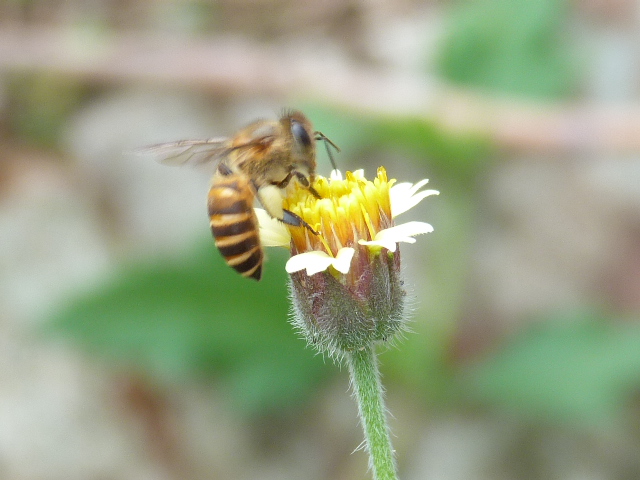NSS Kids’ Fun with the Wildflowers of Bidadari
By Gloria Seow, Education Group
Chairperson
Photos by Lena Chow
 |
| Common Vernonia, a tiny wildflower that is widespread in Singapore. |
Bidadari Cemetery was exhumed between 2001 and 2006. Today, the
former Muslim side of Bidadari is overgrown and wild, serving as a magnet for
migratory birds and the foraging grounds for a good number of wildlife species.
Bidadari also offers a motley assemblage of plant life ranging from figs to
wildflowers. But come December 2012, much of this green expanse is slated to
give way to both public and private housing developments.
The Education Group was privileged to have Yap Von Bing and Angie Ng lead us on a hunt for Bidadari’s wildflowers and botanical wonders on 15 September 2012. Uncle Von Bing came armed with his compact wildflower guidebook published by the Singapore Science Centre. We met at the entrance of Woodleigh MRT station, right by the Christian side of the previous burial grounds. This portion of Bidadari is now open parkland with flat fields criss-crossed by running tracks, and interspersed with the occasional bush or tree.
 |
| The distinct yellow petals of the Yellow Creeping Daisy made identification a cinch. |
Immediately,
we spotted a cheerful patch of Yellow
Creeping Daisy (Wedelia trilobata). Its
distinct yellow petals made identification a cinch. However, the other
wildflower species we were to come across were far smaller and relatively inconspicuous.
We had to carefully examine what was underfoot before discovering a surprising array
of miniscule beauties.
 |
| A bee visiting the Coat Button, a familiar wildflower that can be found in most open fields. |
The most commonly encountered wildflower had to be the
Coat Button (Tridax procumbens). Its long
green stalk blends in with the sea of grass. This is topped by a white-and-yellow
inflorescence that is fairly nondescript from afar, but is rather pretty when
viewed up close. Time and again, we found ourselves bending low to observe tiny
blooms such as the Common Vernonia (Vernonia
cinerea), Common Asystasia (Asystasia
gangetica) and the Malayan Eyebright (Torenia
polygonoides). Not surprisingly, the kids loved the Touch-Me-Not plant (Mimosa pudica with pink pom-pom flowers)
for its thigmonastic effect – its responsive leaflets close immediately upon
touch. These diminutive wildflowers can be found in most open fields.
 |
| The Touch-Me-Not or Mimosa plant was a kids’ favourite for its thigmonastic leaflets that close immediately upon touch. |
After a bout of squinting, we were happy to see the
big yellow flowers of the Mickey Mouse Plant (Ochna kirkii) flanked by its red and green fruit that resembles the
eponymous mouse. Auntie Angie then pointed out the fragrant white blooms of the
Tembusu tree (Fagraea fragrans). We
were particularly drawn to the attractive pink flowers of the Rain Lily (Zephyranthes grandiflora).
 |
| The red and green fruit of the Mickey Mouse Plant supposedly resembles the eponymous mouse. |
Uncle Von Bing next taught the kids the telltale signs
of a Ficus (Fig Tree). Breaking its leaves produces a white sap, while buds of
new leaves appear pointy and sharp. He demonstrated these traits in the Waringin
(Ficus benjamina) and the Bodhi Tree (Ficus Religiosa). We also came across
botanical curiosities such as the aromatic Indian Curry Leaf (Murraya
koenigii), the antioxidant-filled fruit of the Noni Tree (Morinda citrifolia), and the locally widespread Acacia (Acacia auriculiformis), a leguminous
tree originally from Australia that has curly pods containing black seeds and edible
yellow arils. Upon examining the bare carcass of a fallen tree (probably struck
by lightning), we found remnants of a mistletoe that once grew on it. It was
fascinating to note that the tree had a light brown bark, contrasting with the
mistletoe’s almost-black branches.
After the session, some of us crossed Upper Aljunied Road and strolled over to the heavily wooded side of Bidadari that once held a Muslim cemetery. This is the core conservation area in NSS’ recently submitted plans to the authorities. To date, some 141 bird species have been recorded in this relatively small grove, giving it the highest bird density in Singapore. Fifty nine of these are migratory, with many rare birds showing up in recent years. Apart from buildings, the authorities also have plans for a public park. The park’s boundary is roughly the same size and has some overlap with our proposed conservation area, giving NSS some hope of a compromise.
No comments:
Post a Comment